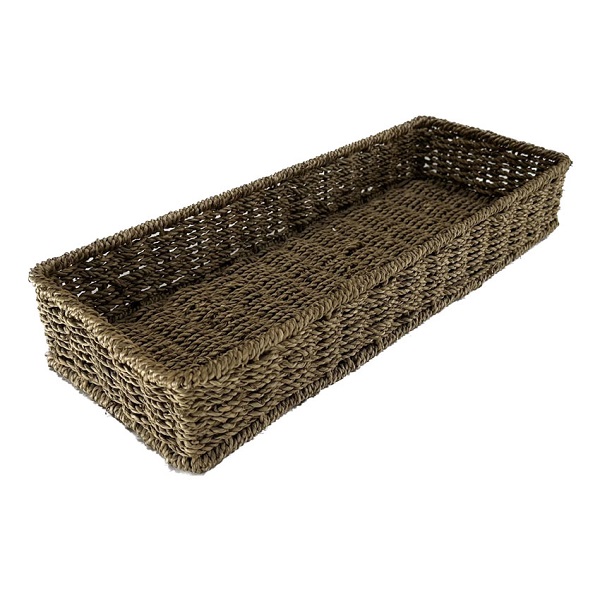Views: 251 Author: Vickey Publish Time: 2024-05-10 Origin: Site









Seagrass baskets have long been cherished for their natural beauty, durability, and versatility. From their humble origins in traditional cultures to their modern-day adaptation in contemporary design, these woven wonders continue to captivate artisans and consumers alike. In this comprehensive exploration, we'll journey through the traditional uses of seagrass baskets, uncover the cultural significance behind their craftsmanship, and trace their evolution over time. Join us as we delve into the rich history and timeless elegance of seagrass baskets, celebrating their enduring appeal and enduring legacy.
Seagrass baskets trace their origins back to ancient civilizations, where natural materials such as reeds, grasses, and fibers were woven into functional and decorative vessels for various purposes. In coastal communities around the world, seagrass—a type of marine plant found in shallow coastal waters—provided an abundant and sustainable source of raw material for basket weaving.
●Storage and Organization: One of the primary uses of seagrass baskets in traditional cultures was for storage and organization. From storing grains and foodstuffs to organizing household items and personal belongings, seagrass baskets provided a practical and aesthetically pleasing solution for keeping essentials tidy and accessible.
●Transport and Trade: Seagrass baskets were also used for transporting goods and commodities, serving as durable containers for carrying produce, textiles, and other goods to markets and trading centers. Their lightweight yet sturdy construction made them ideal for long-distance travel and trade routes.
●Cultural and Ceremonial Significance: In many cultures, seagrass baskets held significant cultural and ceremonial importance, symbolizing themes of fertility, abundance, and unity. They were often used in rituals, ceremonies, and celebrations, such as weddings, festivals, and religious ceremonies, where they played a central role in traditional customs and practices.
●Artisanal Craftsmanship: The art of weaving seagrass baskets was passed down through generations, with skilled artisans employing intricate techniques and patterns to create beautifully crafted vessels. Basket weaving served as a form of artistic expression and cultural heritage, preserving traditional craftsmanship and indigenous knowledge.
●Home Decor and Interior Design: In recent years, seagrass baskets have experienced a resurgence in popularity as decorative accents for home decor and interior design. Their natural texture, earthy tones, and organic appeal complement a wide range of decor styles, from coastal and bohemian to minimalist and Scandinavian.
●Sustainable Living: As awareness of environmental sustainability grows, seagrass baskets have emerged as eco-friendly alternatives to plastic and synthetic storage solutions. Made from renewable and biodegradable materials, seagrass baskets align with the principles of sustainable living and conscious consumption.
●Artisanal Revival: The revival of traditional crafts and artisanal techniques has sparked renewed interest in seagrass basket weaving among contemporary makers and designers. Artisans are experimenting with innovative designs, shapes, and patterns, infusing traditional craftsmanship with modern aesthetics and creative flair.
●Social Impact and Empowerment: Seagrass basket weaving provides economic opportunities and empowerment for artisans, particularly women in rural communities. By preserving traditional skills and supporting sustainable livelihoods, the production and sale of seagrass baskets contribute to poverty alleviation and community development.
●Cross-Cultural Collaboration: Seagrass basket weaving has become a platform for cross-cultural collaboration and exchange, bringing together artisans, designers, and consumers from diverse backgrounds. Collaborative projects and partnerships promote cultural exchange, mutual respect, and appreciation for traditional crafts.
In conclusion, seagrass baskets embody a timeless elegance that transcends time and cultural boundaries. From their traditional uses in storage, transport, and ceremony to their modern evolution as decorative accents and sustainable lifestyle products, seagrass baskets continue to inspire and enchant artisans and consumers around the world. As we celebrate the enduring legacy of seagrass basket weaving, let us honor the rich heritage, craftsmanship, and cultural significance that define these woven wonders.
Briefly explain the usage scenarios of animal basket for storage
What Are the Key Materials Used in Handmade Baskets That Affect Their Durability?
How Do You Choose the Right Handmade Basket for Storage or Decoration?
What Are Woven Vases and How Do They Add a Unique Touch to Your Decor?
How Do You Choose the Right Size for a Rattan Bread Basket to Complement Your Space?
What Are the Different Weaves and Styles in Seagrass Baskets?
How Do You Incorporate Water Hyacinth Baskets into Your Home Decor for an Eco-Friendly Touch?
How Can Woven Storage Baskets Help You Declutter and Organize Your Space?
What Are Some Creative Ways to Arrange Products in Store Display Baskets?